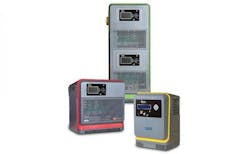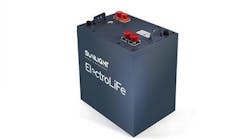In the not too recent past, conventional, or “overnight” charging was the only way to charge a lead-acid truck battery. It involved a lot of manual labor and maintenance activities to ensure your battery was fully charged. Thankfully, advances in battery and charger technologies are now allowing lift truck operators to reduce maintenance even while boosting power, reducing cost, and maximizing battery life cycle. With so many different products available on the market, how do you decipher which battery or charger solution is right for your stored power needs? It’s time to learn the facts and take charge!
Back to the basics
Simply put, conventional lead-acid batteries need to be “changed out” when it’s time to charge – that is, they must be removed from the lift truck, placed on a rack, and connected to a charger. There are multiple types of conventional chargers for lift truck batteries including Ferroresonant and Silicon-Controlled Rectifier (SCR) chargers for traditional flooded and sealed lead-acid batteries. The batteries are charged at a rate of 16-18A/100 Ampere-hours (Ah) for 8 hours, cooled for 8 hours, and then put back into use.
Beyond the significant time involved, conventional charging systems carry inherent safety risks for operators. That’s because some lift truck batteries can weigh upwards of 2,000 lb. and changing them manually requires the use of a battery extraction system and, depending on the recommended procedure, one to two operators. In heavy-use or multi-shift operations, these time-consuming labor requirements drive costs, as does the need to maintain more back-up batteries and a much larger battery fleet overall. Battery management systems can help mitigate some of these issues by optimizing battery charging and change-outs, but like any efficiency upgrade, they require an additional investment upfront.
Battery charging pros and cons
Weighing out the pros and cons of conventional charging, opportunity charging, and fast charging is no easy task. The first step is to analyze your facility’s equipment and operational needs. This can be done through an on-site power assessment, usually conducted by a battery and charger dealer or manufacturer. In order to gather the right information, the conductor will ask the facility operator a series of questions about the lift truck and warehouse environment, including the battery compartment size in the lift truck, minimum battery weight requirements, the number of shifts and much more. This approach can more accurately assess a facility’s needs.
Lift truck batteries are also outfitted with sensors that capture operating data, which is then traced and translated by monitoring system software over several weeks. Factors such as amp-hour throughput or usage, charging patterns, and idle time are examined to determine the best battery and charger fit for the operation. It’s also important to note that the charger must match the battery output voltage (12, 24, 36, etc.).
An innovative charging solution
Demand for longer-running lift trucks to increase day-to-day productivity has given rise to high-frequency, fast, and opportunity chargers that are aimed at expediting the charging process, reducing downtime and freeing up space for other activities versus conventional charging. Generally speaking, the features and benefits of opportunity and fast charging are as follows:
Opportunity charging: An ideal charging solution for extended shift operations where battery changing and battery rooms can be eliminated. With opportunity charging, the batteries are charged at 25A/100Ah while they remain on the truck. Maintenance is reduced to performing weekly and monthly services and there is no changing, charging and cooling of multiple batteries throughout the day. The use of single-point watering systems is required because the batteries don’t leave the truck.
Fast charging: In contrast to conventional charging, fast charging charges the battery at rates of 40-60A/100Ah (3 to 4 times as fast as conventional rates) at every opportunity possible. Multi-shift facilities benefit the most from fast charging because it can eliminate battery handling equipment and battery rooms, helping to drastically reduce operating costs. Fast charge batteries also require the use of a single-point watering system – which means users don’t have to remove the battery from the lift truck to water it.
The next generation of EnerSys chargers
As demand for faster, more flexible charging continues, EnerSys has responded through the consolidation of its Motive Power charger line. The Motive Power charger portfolio is now organized according to performance and charging profiles. With some of the lowest component counts in the industry, EnerSys chargers feature advanced designs that promote reliability and easier serviceability. The consolidated list of chargers includes:
- IMPAQ™ chargers – this high-frequency, value-packed charging solution is equipped with the latest technology and features of a standard flooded lead-acid battery charge profile. IMPAQ™ chargers now include the proprietary NexSys block and standard charge profile.
- NexSys+ chargers – for added performance and value, these chargers include the NexSys charge profile plus the EnerSys proprietary IONIC™ charge profile to continuously diagnose and optimize battery condition throughout the charging process.
- Express chargers – these chargers increase productivity by quickly and safely charging fast-charge batteries anytime during a shift. They are designed exclusively for Express batteries.
Each charger is equipped with a programmable menu or analytics technology to maximize charging performance and provide enhanced diagnostics and feedback to the operator to ensure optimal charging at every plug-in.
So which EnerSys charging solution would work best for your facility? Again, the answer depends on several factors that also dictate your best battery option. Fortunately, your battery and charger options can be accurately determined with an on-site power assessment, or with EnerSys EnSite calculation software.
For more about the features and benefits of TPPL battery technology, visit www.enersys.com.
Authored by: Zach Essig
Zach Essig is Technical Marketing Manager, Motive Power Americas for EnerSys, the global leader in stored energy solutions for industrial applications. Having served in a range of materials handling industry roles for nearly a decade, Essig enjoys sharing his knowledge of the field and the stored power technologies that support it.





